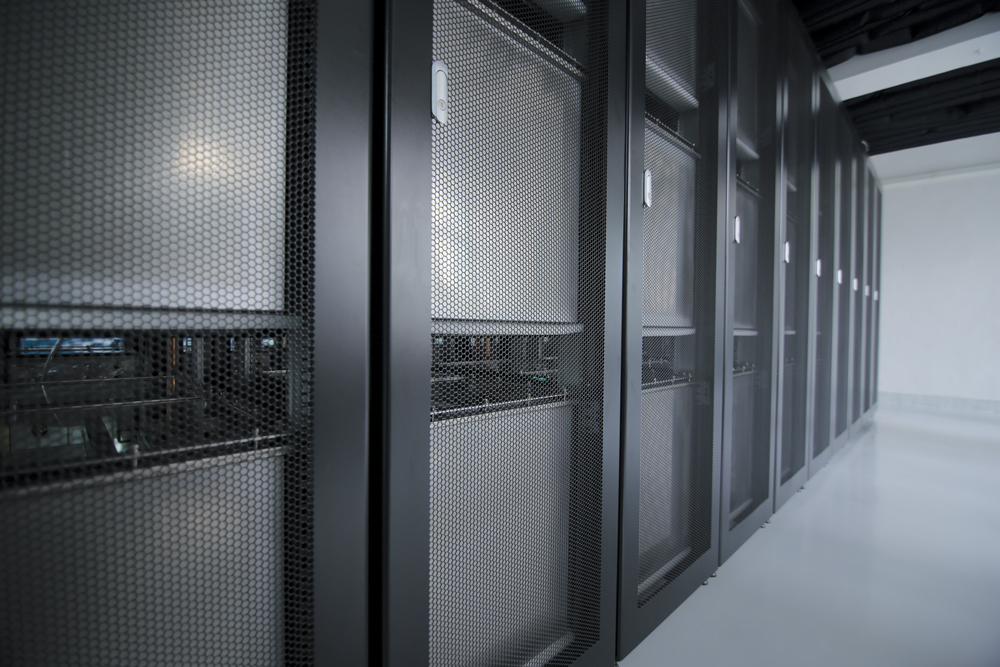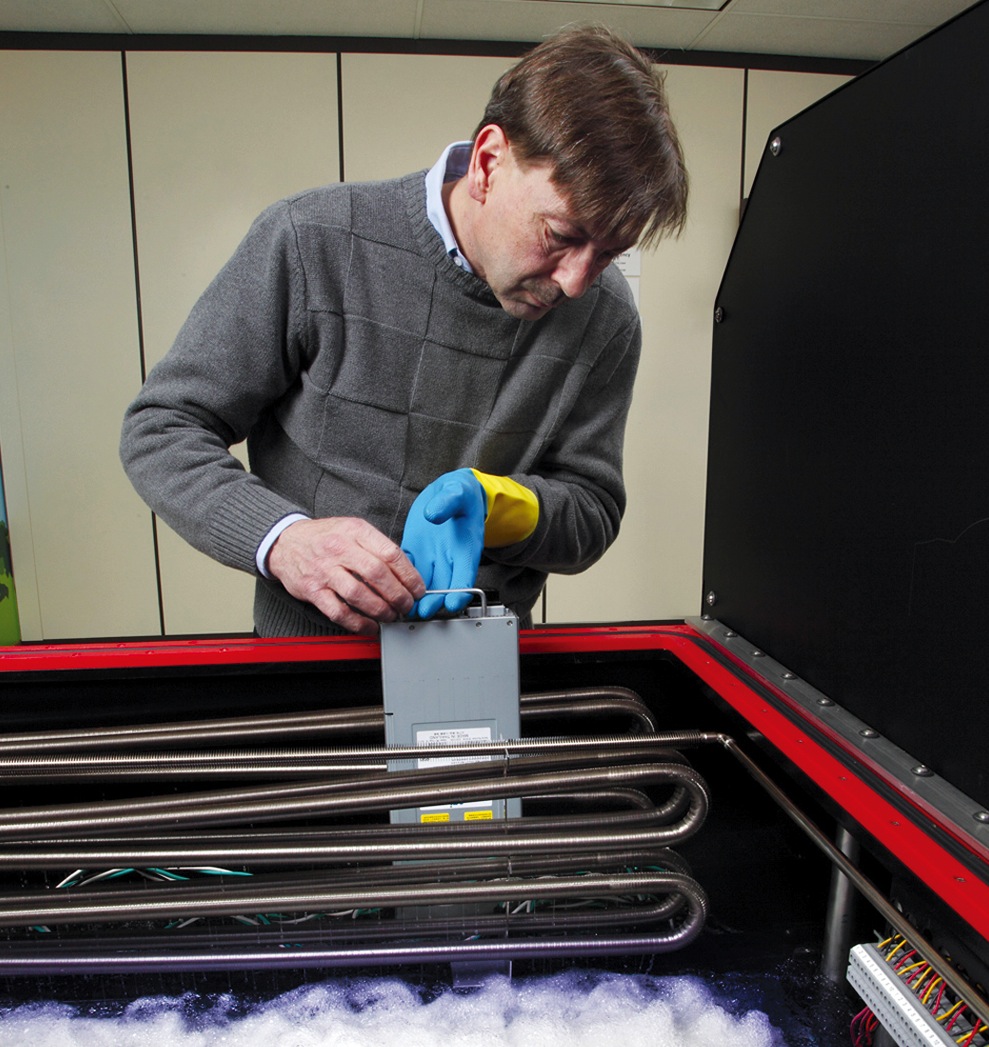In the rush to slash energy consumption in power-hungry data centers, design teams, equipment manufacturers, and tech companies have been developing clever, low-energy cooling solutions—from Facebook’s open-rack server setup with exposed motherboards, to Skanska’s eOPTI-TRAX liquid refrigerant coil system, to Google’s evaporative cooling schemes.
Solutions like these have helped data center facility operators achieve unprecedented energy performance levels, with power utilization effectiveness (PUE) ratios dipping below 1.10 in some instances. This means that less than 10% of the total energy consumption in a facility is attributed to noncomputing functions, such as air-conditioning and lighting.
Now, a new technology promises to push the limits of data center energy efficiency even further. Called immersive cooling, it uses a liquid instead of air to cool the servers. LiquidCool Solutions, Green Revolution, and 3M are among the pioneers of this technology. Each system works a bit differently, but the basic idea is to submerge the motherboards in tanks filled with nonconductive fluid, which absorbs the heat generated by the processors.
LiquidCool Solutions, for example, uses an enclosed server module and pumps dielectric fluid through the server enclosure. Green Revolution uses a tub full of dielectric oil and circulates the liquid through the tubs. 3M also uses the tub approach, but the fluid boils and then is condensed to reject the heat.
By using liquid-based cooling at the server level, the need for air-conditioning is greatly reduced, or even eliminated in some climates. The same goes for traditional HVAC equipment and systems—chillers, fan units, raised floors, and so on.

The Allied Control 500 kW immersion-cooled data center in Hong Kong is capable of delivering a PUE of just 1.02. The standard, 19-inch server racks use 3M Novec Engineered Fluids to enable tight component packaging for greater computing power in less space, according to Allied. Its open-bath design permits easy access to hardware and eliminates the need for pressure vessel enclosures and charging/recovery systems. PHOTO: COURTESY ALLIED CONTROL
“In most parts of the world, compressorized cooling would not be required with immersive cooling, since the liquid temperatures can be at a level where direct heat rejection using outdoor condensers or cooling towers would be sufficient,” says Thomas Squillo, PE, LEED AP, Vice President with Environmental Systems Design, who is currently researching the technology for the firm’s data center clients. “The fan energy is also eliminated, both in the HVAC system and in the server itself. Fluid pumping energy is very low.”
Other advantages of the cooling technology, according to Squillo:
• Increased performance and service life of the computer chips by eliminating heat buildup and problems related to contaminated air and dust.
• Ability to deploy data centers in extremely harsh environments without greatly impacting energy performance.
• Potential construction cost savings by downsizing or eliminating traditional HVAC systems.
Other than a few pilot projects, including a Bitcoin mining data center in Hong Kong and a Lawrence Berkeley National Laboratory-led installation in Chippewa Falls, Wis., immersive cooling technology is largely untested. A year into the Bitcoin pilot, the data center operator reported a 95% reduction in cooling costs.
AEC professionals are starting to realize the potential for immersive cooling, especially for high-performance computing centers and consolidated, high-density data centers.
“Large data centers that have many homogenous machines at high density—like those operated by Internet and cloud providers—are a good application,” says Squillo. “Small footprint and minimal energy use are very important due to the volume of servers. These can be deployed in remote areas where space and energy are cheap, but where air quality may be a concern, without having to worry about the data center air.”
TRICKY DESIGN CONSIDERATIONS
Before the technology can be implemented, says Squillo, several nettlesome design factors specific to immersive cooling have to be addressed:
• Piping distribution to the racks and cooling units requires redundancy and valving to accommodate equipment maintenance without disrupting server performance.
• Additional equipment and space are needed to drain fluid from the tanks for server maintenance.
• Local code requirements may limit the amount of fluid that can be stored in a single room.
• For the foreseeable future, it’s unlikely that a large data center would be 100% liquid-immersion cooled. This means provisions will have to be made for both air- and liquid-cooling systems, which will require additional space in the data hall and mechanical room.
“I think that some form of this technology will definitely be the direction the data center market will take in the future,” says Squillo. “The market just needs to mature enough for owners to trust the technology and demand servers that are designed for a particular type of liquid cooling. In the short term, I see large companies and server manufacturers doing small-scale installations to test the concept, before wanting to implement it at a large scale.”
Related Stories
Healthcare Facilities | Mar 18, 2024
A modular construction solution to the mental healthcare crisis
Maria Ionescu, Senior Medical Planner, Stantec, shares a tested solution for the overburdened emergency department: Modular hub-and-spoke design.
Codes and Standards | Mar 18, 2024
New urban stormwater policies treat rainwater as a resource
U.S. cities are revamping how they handle stormwater to reduce flooding and capture rainfall and recharge aquifers. New policies reflect a change in mindset from treating stormwater as a nuisance to be quickly diverted away to capturing it as a resource.
Plumbing | Mar 18, 2024
EPA to revise criteria for WaterSense faucets and faucet accessories
The U.S. Environmental Protection Agency (EPA) plans to revise its criteria for faucets and faucet accessories to earn the WaterSense label. The specification launched in 2007; since then, most faucets now sold in the U.S. meet or exceed the current WaterSense maximum flow rate of 1.5 gallons per minute (gpm).
MFPRO+ New Projects | Mar 18, 2024
Luxury apartments in New York restore and renovate a century-old residential building
COOKFOX Architects has completed a luxury apartment building at 378 West End Avenue in New York City. The project restored and renovated the original residence built in 1915, while extending a new structure east on West 78th Street.
Multifamily Housing | Mar 18, 2024
YWCA building in Boston’s Back Bay converted into 210 affordable rental apartments
Renovation of YWCA at 140 Clarendon Street will serve 111 previously unhoused families and individuals.
Healthcare Facilities | Mar 17, 2024
5 criteria to optimize medical office design
Healthcare designers need to consider privacy, separate areas for practitioners, natural light, outdoor spaces, and thoughtful selection of materials for medical office buildings.
Construction Costs | Mar 15, 2024
Retail center construction costs for 2024
Data from Gordian shows the most recent costs per square foot for restaurants, social clubs, one-story department stores, retail stores and movie theaters in select cities.
Architects | Mar 15, 2024
4 ways to streamline your architectural practice
Vessel Architecture's Lindsay Straatmann highlights four habits that have helped her discover the key to mastering efficiency as an architect.
Healthcare Facilities | Mar 15, 2024
First comprehensive cancer hospital in Dubai to host specialized multidisciplinary care
Stantec was selected to lead the design team for the Hamdan Bin Rashid Cancer Hospital, Dubai’s first integrated, comprehensive cancer hospital. Named in honor of the late Sheikh Hamdan Bin Rashid Al Maktoum, the hospital is scheduled to open to patients in 2026.
Codes and Standards | Mar 15, 2024
Technical brief addresses the impact of construction-generated moisture on commercial roofing systems
A new technical brief from SPRI, the trade association representing the manufacturers of single-ply roofing systems and related component materials, addresses construction-generated moisture and its impact on commercial roofing systems.

















